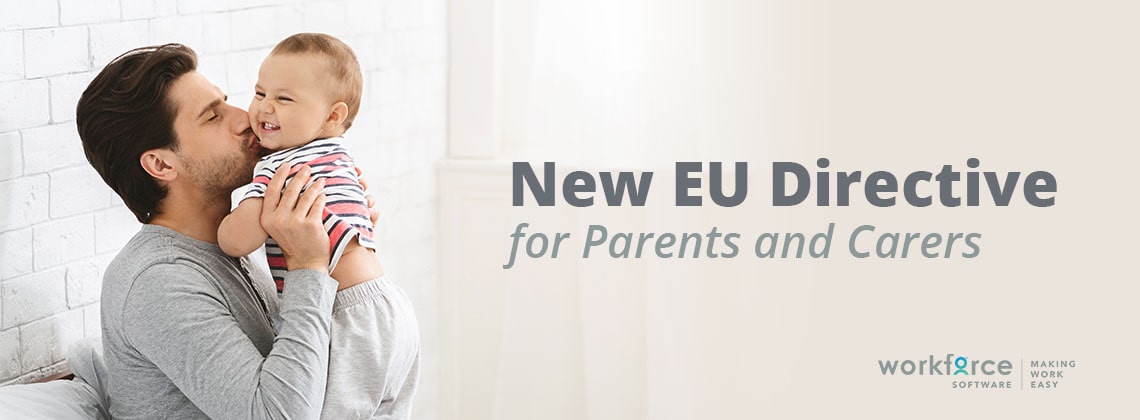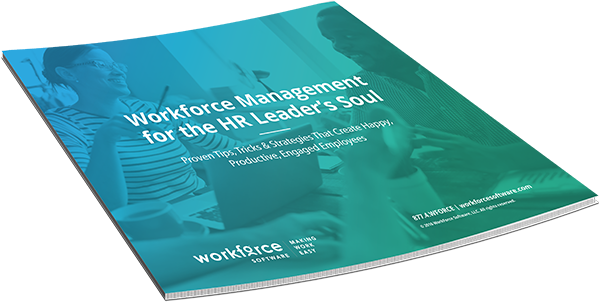New EU Directive for Parents and Carers


David Barker
Director, Product Management – EMEA & APAC
In June of this year the European Parliament voted to enact a new Directive on work-life balance for parents and carers. This Directive, that had been in the pipeline for some time, is motivated by a number of factors including the continued drive for equality in the workplace for men and women and providing additional incentives for men to participate in the care and upbringing of children. It is also recognised across the European Union that macro-level social and economic changes–including an aging population–placing pressure on public spending are leading to a greater need for informal care. To this end the Directive also recognises that beyond its scope, Member States must continue to improve provision for accessible and affordable childcare and long-term care services.
The Details
For clarity, it is worth defining the four key concepts covered by the directive:
- Paternity Leave means leave from work for fathers (or where recognised, equivalent second parents) on the occasion of the birth of a child for the purposes of providing care.
- Parental Leave means leave from work for parents on the grounds of the birth or adoption of a child to take care of that child. As we shall see below, this could be spread over several years.
- Carer’s Leave means leave from work in order to provide personal care or support to a relative, or to a person who lives in the same household and who is in need of significant care or support for a serious medical condition.
- Flexible Working Arrangements means the possibility for workers to adjust their working patterns through the use of remote working arrangements, flexible working schedules, or reduced working hours.

The principle provisions of the Directive are:
Fathers (or second parents) shall be entitled to a minimum of 10 working days paternity leave irrespective of their length of service or marital/family status. That leave must be paid at a rate not less than the parent would receive if they were on sick leave, although that pay can be subject to an employment qualification of no more than six months. The pay requirement is a direct attempt to increase the number of fathers that take advantage of paternity leave.
All parents shall be entitled to four months of parental leave to be taken before the child reaches a certain age (not less than 8 years). Importantly, two months of that leave cannot be transferred to the other parent–this is to help ensure that both parents take a share of parental duties. Across the EU only around 10% of fathers currently take advantage of parental leave. The right to leave can be dependent on length of service (the qualification being no more than one year). The level of pay for parental leave “shall be set in such a way as to facilitate the take up of parental leave by both parents” which is surely open to interpretation and legal argument for years to come.
Workers are to have the right to five working days of carer’s leave each year, but the detail is left to national legislation. Related to this, workers shall also have the right to time off for urgent family reasons such as accident or illness.
Finally, carers and workers with children up to a specified age (not less than 8 years) shall have the right to request flexible working arrangements for caring purposes. There are certain associated rights–such as the right to return to normal working arrangements–but again much of the detail is left to local legislation.
This Directive (2019/1158) replaces an earlier one from 2010 and must be transposed into national legislation within three years.
 Workforce Management for the HR Leader’s Soul
Workforce Management for the HR Leader’s Soul
This book will help you create a healthy, rewarding environment for the people that keep your company moving forward.
Impact on National Legislation
All EU member countries already have legislation that covers some or all of the requirements of this new Directive. According to a 2018 European Commission report on paternity and parental leave policies across the EU, 17 Member States already meet the minimum 2 weeks paternity leave, but only 13 offer 2 weeks well paid leave. The situation with parental leave is much more variable–while all states have some form of parental leave, very few meet the new requirements of minimum length, non-transferability, eligibility, and level of pay. A recent report from UNICEF highlights the wide variability in family rights across Europe.
So as a result of this new Directive, each Member State will have to review its legislation and amend it where necessary in order to bring it in line with the new rules by August 2022. For some countries this could entail significant change.

Impact on Employers
For employers, this means more change in terms of compliance with workforce management rules. With the tightening of requirements for pay during family leave it seems entirely possible that, as we have seen in the debate over holiday pay, we will end up with a set of pay rules for the time off covered by the legislation and a different set for any additional time provided by the employer or by local collective agreement. The result confirms that managing family leave is getting more complicated for employers. A flexible absence management solution is increasingly becoming a ‘must have’. For family leave, as well as other types of absence, the only certainty is that further changes are to be expected over the coming years.
Subscribe to The WorkForce Blog
Learn the art and science of maintaining productive, happy, engaged employees.
More Awesome Content!
Embedding an ‘Eyes Wide Open’ Mindset Into HR Technology Selection
Gartner guides teams responsible for deciding on their organization’s next HR technology investment to set themselves up for success.
5 Workforce Management Secrets to Thrive in 2021 and Beyond
Download this eBook to learn the 5 secrets that will help your organization shift from surviving to thriving now and in the future and learn how the right workforce management solution can empower your initiatives.
How Next-Gen Time Management Supports System of Record Compliance
Businesses must evaluate their time tracking solutions to ensure the solution meets compliance and efficiency needs.

 Workforce Management for the HR Leader’s Soul
Workforce Management for the HR Leader’s Soul

